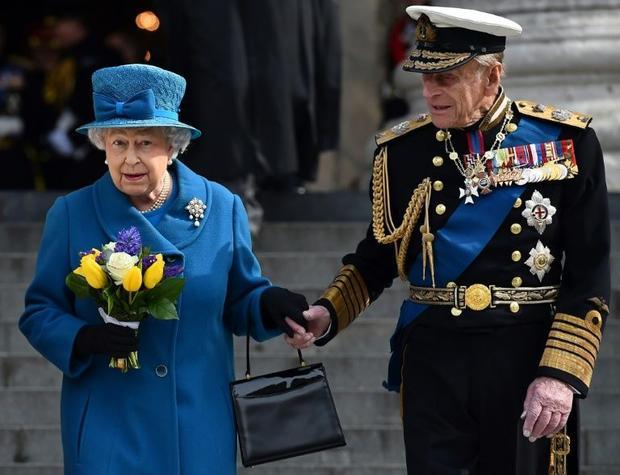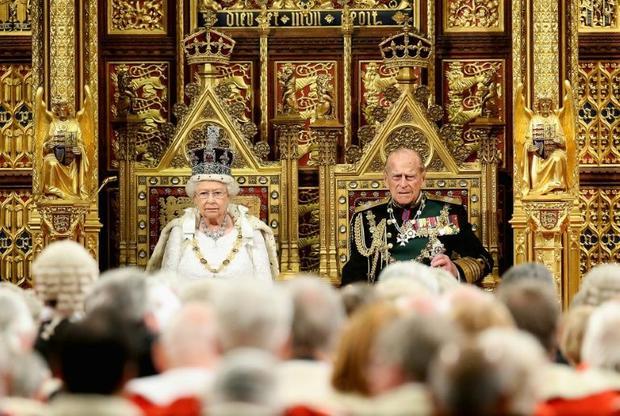Prince Philip‘s coffin will be carried in a Land Rover he helped customize during his funeral procession on Saturday at Windsor Castle, The Associated Press reports.
A Land Rover TD5 130 that was modified to the late Duke of Edinburgh’s liking between 2003 and 2019 will be used to transport his hearse to St. George’s Chapel, where the funeral and interment will occur.

Prince Philip made several requests for changes to the vehicle since it was built when he was 82. Some modifications included added an open-top rear section with several stops to hold his coffin securely in place. He also requested the color be changed to a dark bronze-green to resemble military Land Rovers.
The final alteration was made when Prince Philip turned 98, the AP notes.
Land Rover was “deeply privileged” to have helped create the vehicle for Philip, Thierry Bollore, Land Rover’s chief executive, told the AP.
Land Rover did not immediately respond to The Hill’s request for comment.
The longtime husband to England’s Queen Elizabeth II passed away on April 9 at the age of 99. He had been in and out of the hospital in the months prior to his death.
Prince Philip often grabbed headlines for his outspoken remarks but was portrayed by royalists as the silent stalwart, who shelved his personal ambitions to support Queen Elizabeth II over seven decades.

Born into the Greek royal family — although he preferred to be thought of as a Danish prince — the Duke of Edinburgh never wore a crown himself.
Yet he was a permanent public presence at the queen’s side, who called him her “strength and stay”.
Like her, his life was ruled by duty and tradition, putting his considerable energy behind numerous charities and carrying out 22,219 solo public engagements since Elizabeth rose to the throne in 1952.
But Philip regularly got into hot water for what were politely referred to as “politically incorrect” off-the-cuff remarks — quips that from anyone else would be seen as downright racist.
“You managed not to get eaten, then?” he remarked to a British student who had trekked in Papua New Guinea in 1998.

There was also his reputation as a womanizer, something that worried the royal family even before he and the queen married.
They reportedly found the young naval officer “rough, ill-mannered and uneducated” and worried he “would probably not be faithful”.
The man the queen’s formidable mother privately referred to as “The Hun” because of his German Battenberg blood, was quickly suspected of a string of affairs, which would later be resurrected in the hit Netflix series “The Crown”.
But Philip laughed off talk of philandering — with Sarah, the Duchess of York’s mother, often cited as one of his former lovers.
“For the last 40 years, I have never moved anywhere without a policeman accompanying me. So how the hell could I get away with anything like that?” he said.
At home, the duke had a reputation for being cold towards his four children, Charles, Anne, Andrew, and Edward.
But many observers considered Philip to be the glue that held together with the modern royal family.
And in a rarely seen softer side, it emerged the late princess Diana addressed him as “Dearest Pa” in letters in which he offered solace over her deteriorating marriage to his eldest son Charles.
– ‘Trial and error’ –
Philip, who was the world’s longest-serving consort, was blessed with robust health for much of his life and conducted his final official appearance in August 2017 aged 96.
But he was admitted to hospital with various complaints as he advanced into his 90s, most recently for a heart procedure.
In January 2019, at the age of 97 and still driving, he was involved in a car accident near the royal estate of Sandringham in eastern England.
His Land Rover Freelander overturned and two other motorists were injured.
Prosecutors decided not to press charges after the prince, who walked away unscathed, voluntarily surrendered his driving license.
The accident saw him withdraw from public life and he spent much of 2020 in isolation with the queen at their Windsor Castle home west of London, shielding from the coronavirus pandemic.
But he made several appearances, including at the wedding ceremony of his granddaughter Princess Beatrice in July, four months before celebrating his own 73rd wedding anniversary.
He also attended a military ceremony at Windsor in July when he handed over his ceremonial military role as Colonel-in-Chief of The Rifles regiment to Charles’ second wife, Camilla, Duchess of Cornwall.
Never one to talk about his own feelings, the prince admitted in a rare 2011 interview that he had carved out his own role in the royal family by “trial and error”.
Asked if he had been successful, he told the BBC in his typically forthright manner: “I couldn’t care less. Who cares what I think about it? I mean it’s ridiculous.”
But the queen has been more forthcoming about his worth.
“He has, quite simply, been my strength and stay all these years,” she said in a speech to mark their golden wedding anniversary in 1997.
– Born on a kitchen table –
Prince Philippos of Greece and Denmark was born on a kitchen table on Corfu on June 10, 1921, the only son of Prince Andrew of Greece — the younger brother of Greece’s King Constantine — and Princess Alice of Battenberg.
The family settled in Paris with young Philip heading to the austere Gordonstoun public school in Scotland, where he became head boy.
He pursued his love of sailing and at the outbreak of World War II in 1939 became an outstanding Royal Navy cadet before serving on battleships in the Indian Ocean and the Mediterranean.
As the war progressed, Philip was mentioned in despatches and promoted through the ranks.
By 1945, he was a first lieutenant and witnessed the Japanese surrender in Tokyo Bay with the British Pacific Fleet.
Philip had been formally introduced to princess Elizabeth, the future queen, in July 1939.
The pair shared a great-great-grandmother — Queen Victoria — making them distant cousins, and they kept in touch during the war, meeting on a number of occasions.
But it was not until July 1947 that their engagement was announced and they tied the knot that year on November 20 at Westminster Abbey in London.
– ‘Duty to serve her’ –
The royal couple made their first major tour together — to Canada and the United States — in 1951.
By now a commander, Philip’s naval career was cut short by the death of Elizabeth’s father, King George VI, in 1952, which brought her to the throne.
“Prince Philip was a highly talented seaman,” said his contemporary Terence Lewin. “If he hadn’t become what he did, he would have been First Sea Lord (chief of naval staff) and not me.”
Philip once admitted the curtailment of his career was “disappointing” but said, “being married to the queen, it seemed to me that my first duty was to serve her in the best way I could”.
Yet he remained closely involved with the armed services and the queen marked his 90th birthday in 2011 by appointing him Lord High Admiral — the titular head of the British Royal Navy and an office until then held by her.
He also maintained an interest in science, technology, and the environment and for years drove a liquid petroleum gas taxi around London.
His greatest legacy may lie in the Duke of Edinburgh’s Award scheme, which was set up in 1956 to develop the confidence and skills of young people aged 15 to 25 in Britain and the Commonwealth.
His youngest son, Edward, said its importance was likely to be greater due to the effects of the coronavirus pandemic on formal education.
“I think the role of the non-formal in this present climate is going to be even more important than ever before because it’s those skills and experiences which are going to be looked for,” he told Sky News television
Philip was also a patron of a number of organizations, including the World Wide Fund for Nature, and chancellor of the universities of Cambridge and Edinburgh.


